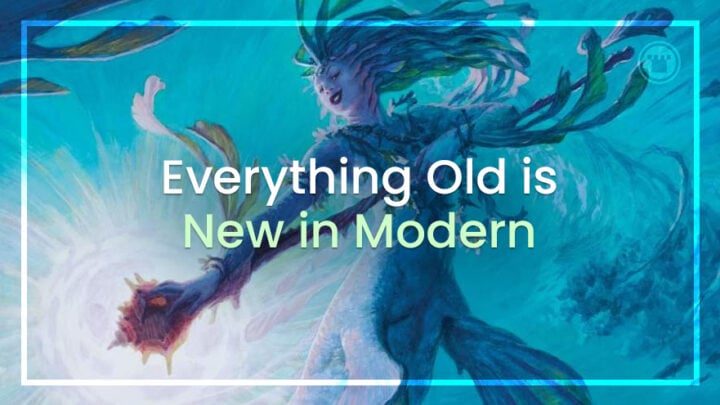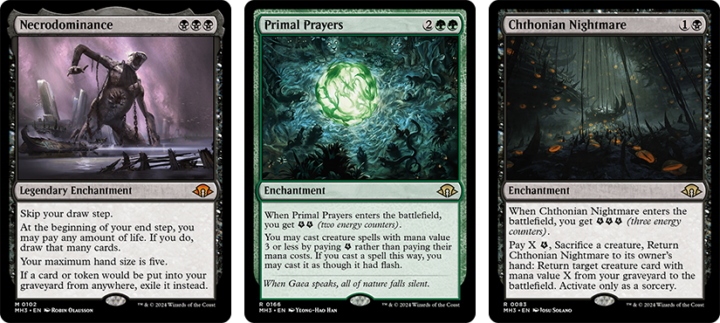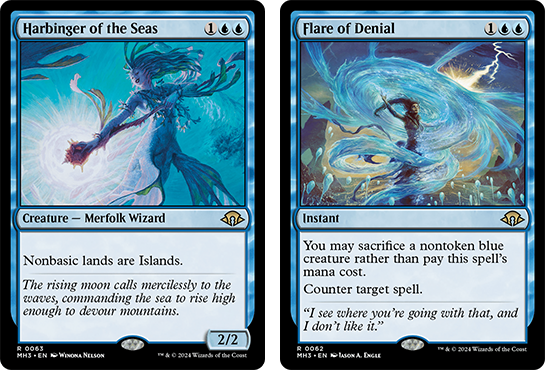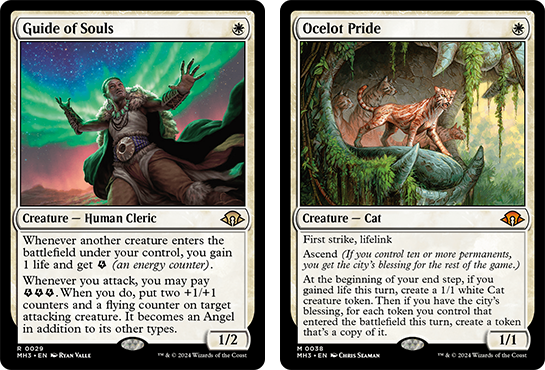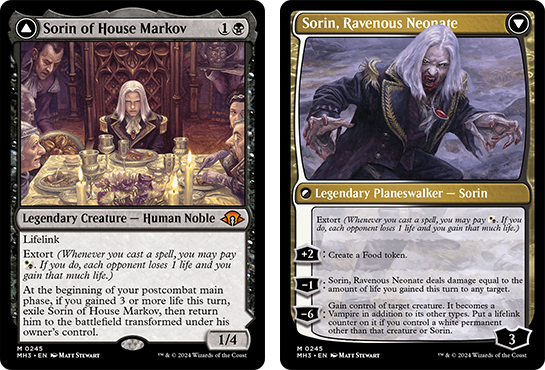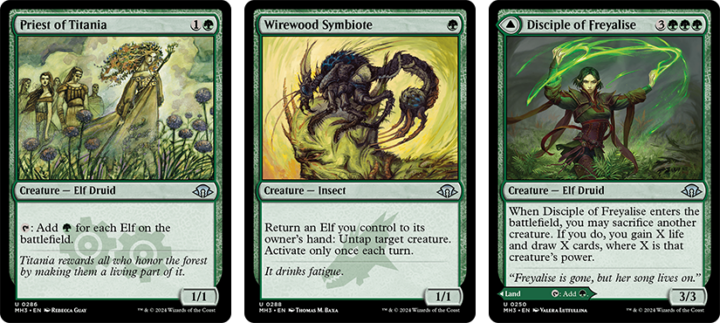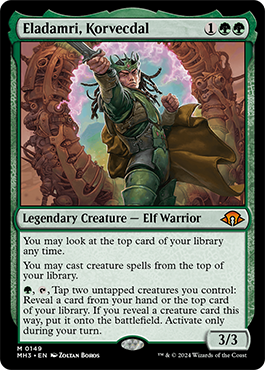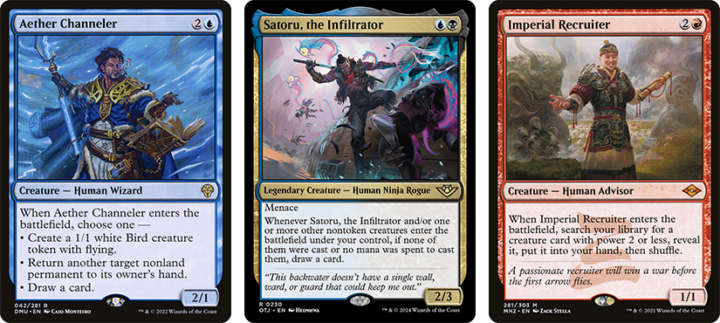It shouldn’t really come as any surprise that Modern Horizons 3 has been a transformative event for the Modern metagame. We’ve seen two previous examples of the format “rotating” after a set’s worth of new pushed cards were added – three if you count Lord of the Rings: Tales of Middle-earth.
It’s also clear that the designers of these sets have a mandate to try and shake up the format by empowering new or fringe archetypes. Modern has never had an Energy deck before – now it has several. Necrodominance, Primal Prayers and Chthonian Nightmare import iconic build-arounds from before Modern’s era to create brand new strategies.
But while these MH3-first archetypes have hogged the headlines, some much more familiar decks have also begun to creep back into relevance. Faded icons which seemed consigned to the history books of Modern, these strategies are suddenly enjoying an injection of life thanks to some choice MH3 additions.
THE FISH ARE BACK
Merfolk has been out of fashion for so long now that it’s known more as a target of jokes than an actual deck. But those jokes only land because of a hardcore fanbase who were forever won over by this unique blue aggro deck back in its heyday, and have remained loyal throughout its protracted dry spell.
Wizards have rewarded that loyalty with new cards in each Modern Horizons set, as well as some Standard-legal gems like Tishana’s Tidebinder and Vodalian Hexcatcher. But it took Modern Horizons 3 to finally push the deck over the top, thanks to the one-two disruption punch of Harbinger of the Seas and Flare of Denial.
Force of Negation was always an awkward fit for a proactive deck which was just as likely to need free countermagic while forcing reactions on its own turn. The new Flare has a cost that is arguably easier for this deck to pay, while being far more flexible in what it can stop.
Meanwhile getting an on-type Magus of the Moon is just as powerful as you might expect for a deck like this. Putting the opponent off their preferred line for even a single turn can be enough for an avalanche of merfolk to crash in and end the game, and Harbinger will often achieve more than that.
It’s probably true that turning nonbasics into Islands is, on average, less likely to cripple an opponent than turning them into Mountains. But then you have to remember that all 8 Merfolk lords in the deck grant your team Islandwalk – so Harbinger also renders your entire team unblockable while it’s in play!
Combining these new assets with MH2 favorites Svyelun and Tide Shaper, plus some “free” interaction slots thanks to Otawara and Sink Into Stupor, you get an ideal combination of hard-hitting disruption and efficient beatdown that maximizes every resource available to punch in early wins. MH3 Merfolk are o-fish-ally no joke!
A NEW LEASE ON LIFE
Martyr of Sands has always been a Constructed underdog, but it has proven a surprisingly persistent one. Gaining huge chunks of life with its signature card gives the deck a head start in any aggro matchup, buying lots of time for advantage engines like Emeria, the Sky Ruin and Abiding Grace.
But prior to MH3, Martyr players had found themselves in a weird spot. The deck was showing consistently strong results online, thanks to recent mono-white control tools like The One Ring and Leyline Binding. However, these builds were relying heavily on the MTGO chess clock system to decide matches in their favor – very few played anything resembling a win condition.
Older Martyr decks had sworn by Serra Ascendant, but that idiosyncratic threat had become less and less reliable over time, and the archetype never got a real second option to help it actually end games if opponents declined to concede.
MH3 included an absolute windfall of great new cards for white decks, and the Guide of Souls + Ocelot Pride package have a lot of appeal for a deck focused on one-drops and lifegain. But the card which instantly drew my eye is not even white at all: Sorin of House Markov.
Flip Sorin is not as interesting or well rounded as Flip Ajani, but in this particular white shell we only need him to do the one thing he does best; convert Martyr of Sands’ excessive lifegain into lethal damage. This is still more of a lategame inevitability tool than a combo the deck will aggressively play towards, but being able to threaten that kind of explosive victory will still help a lot in combo or control matchups where Martyr has to become proactive.
Seeing this deck have any momentum at all in 2024 is crazy to me, and I have no doubt that there are many optimizations to be discovered if good players continue to pick it up. This openness to experimentation is always a big part of the appeal for fringe decks – and clearly MH3 has just made Martyr a lot more appealing.
ELF BALLIN’
Rather than leveraging disruption to steal an early lead like their fishy rivals, the pointy-eared folk are all about raw speed: explosive (if fragile) resource generation allows them to snowball creatures into more creatures until they have critical mass to launch a game-ending nuke like Craterhoof Behemoth or Shaman of the Pack.
Heritage Druid and newly-legal Priest of Titania are the key engines, netting an immediate mana return for every elf you play even if those elves are summoning sick or don’t naturally tap for green themselves.
Elvish Warmaster, Nettle Sentinel and Wirewood Symbiote can all act as multipliers for this mana generation, giving you extra untapped elves to use each turn at no extra cost. Leaf-Crowned Visionary, Disciple of Freyalise, and Elvish Visionary help turn that mana back into more elf cards – but they weren’t quite enough gas on their own.
Enter MH3’s Eladamri, Korvecdal – a versatile curve-topper who both unlocks the top of your library to effectively “draw” many extra creatures per turn, and adds another way to achieve the final step in the gameplan: converting all your mana, draws and creatures in play into a massive finisher spell.
It might not be Natural Order, but Eladamri’s activated ability is still a very nice discount on a Craterhoof – enabling you to potentially bust out a lethal with significantly fewer resources than Chord of Calling would take. Of course you still keep the Chord there for consistency – and if you miss on those wincons altogether, you can probably dump your mana into Ezuri or Elvish Warmaster activations and just get things done the dirty way.
Elves do feel like they lack some of the flexibility in counterplay or sideboarding that you’d hope for in a very fast and scary new Modern, even if they can use Chord of Calling to tutor up their sideboard bullets.
But if the meta ever drifts away from having tons of one-mana creature removal, the Elf deck will be primed to seize that moment and turn it into unstoppable red zone momentum.
PRIMAL HUMANITY
Unfortunately for fans of the 5c Humans archetype and its pre-MH1 dominance, there weren’t any obvious new toys dedicated to this deck as we saw given to Merfolk and Elves.
Hype for Humans was nonexistent in the MH3 release window, and with other decks getting so much stronger it seemed like this once-awesome deck didn’t have a prayer of competing. Thankfully, a sharp-eyed player at a Tacoma regional diagnosed this weakness and added the secret source to take Humans back to the top tables: Primal Prayers.
This hasn’t made the same headlines or seen as much exploration as other MH3 build-arounds have to date. I wonder how much of that is from the Nadu deck directly overshadowing it as the clearly best creature toolbox/combo strategy; I assume we’ll find out whenever the bird gets its much-anticipated ban.
In any case, the game-winning potential is plain to see for anyone aware of Legacy Aluren combo. Free creature spells plus any kind of self-bounce makes it easy to assemble an infinite loop; adding a one-energy tax per creature can be offset by using Greenbelt Rampager or – in this case – Guide of Souls.
With Guide of Souls (a Human) on the field, we can use two copies of Aether Channeler (a Human) to repeatedly bounce each other and gain infinite life. We can then flip Sorin of House Markov (a Human) and -1 for an easy kill. It also helps that the bounce and flicker effects help us rapidly draw our deck once Satoru, the Infiltrator (a Human) is in play – and that all of these creatures are tutorable with Imperial Recruiter (a Human).
It’s a pretty awesome combo which can assemble itself out of nowhere quite easily as soon as Primal Prayers hits play. But the best part of all is that this potent wincon really doesn’t cost the deck much in terms of slots, other than the 4 copies of Prayers itself. Should that plan not come together, you’re still a reasonable Aether Vial deck with Champion of the Parish and Thalia’s Lieutenant backed up by tutorable offensive and defensive interaction.
MY DECK DIDN’T HEAR NO BELL
The writing has been on the wall since at least MH2 for Modern as a “non-rotating” format. Players who want to commit to one deck that stays good for years and years aren’t being ridiculous, but they’re going to have a hard time arguing that ideal with a profit-driven corporation like Hasbro.
Modern, Legacy, Commander – none of these formats are really a refuge anymore against the constant turnover of new meta-defining cards. At least in Pauper you can be confident you won’t be paying hundreds of dollars a year to keep up with these changes!
But I do think that the decks we’ve looked at today are evidence of a more reasonable middle ground for such players (my Martyr-loving self included). For every deck like Boros Energy where 90% of the spells are from MH3, we can see one like Elves which only added Eladamri and Priest of Titania, keeping its familiar playstyle completely intact.
Longtime players of these decks have set an example that fans of newly-displaced archetypes can now learn from. You can still sleeve up your Yawgmoth, or Hammer Time, or Prowess, or 4c Omnath even when they aren’t getting talked about, and you’ll probably still be competitive. You also know a single card in the next set might be enough to shoot your archetype back up the tier list – or simply a shift which leaves the meta cold to your angle of attack.
All of this is to say: if you really love your deck, then stick with it. Very few of us play for the kind of stakes which demand selling our loyalties for a slightly better chance at a Top 8. You might be a lot happier if you just relax and wait for the meta winds to fill your sails once again.

Tom’s fate was sealed in 7th grade when his friend lent him a pile of commons to play Magic. He quickly picked up Boros and Orzhov decks in Ravnica block and has remained a staunch white magician ever since. A fan of all Constructed formats, he enjoys studying the history of the tournament meta. He specializes in midrange decks, especially Death & Taxes and Martyr Proc. One day, he swears he will win an MCQ with Evershrike. Ask him how at @AWanderingBard, or watch him stream Magic at twitch.tv/TheWanderingBard.

